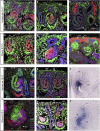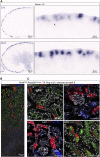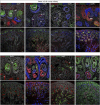Conserved and Divergent Molecular and Anatomic Features of Human and Mouse Nephron Patterning
- PMID: 29449451
- PMCID: PMC5827611
- DOI: 10.1681/ASN.2017091036
Conserved and Divergent Molecular and Anatomic Features of Human and Mouse Nephron Patterning
Abstract
The nephron is the functional unit of the kidney, but the mechanism of nephron formation during human development is unclear. We conducted a detailed analysis of nephron development in humans and mice by immunolabeling, and we compared human and mouse nephron patterning to describe conserved and divergent features. We created protein localization maps that highlight the emerging patterns along the proximal-distal axis of the developing nephron and benchmark expectations for localization of functionally important transcription factors, which revealed unanticipated cellular diversity. Moreover, we identified a novel nephron subdomain marked by Wnt4 expression that we fate-mapped to the proximal mature nephron. Significant conservation was observed between human and mouse patterning. We also determined the time at which markers for mature nephron cell types first emerge-critical data for the renal organoid field. These findings have conceptual implications for the evolutionary processes driving the diversity of mammalian organ systems. Furthermore, these findings provide practical insights beyond those gained with mouse and rat models that will guide in vitro efforts to harness the developmental programs necessary to build human kidney structures.
Keywords: human genetics; kidney development; nephron.
Copyright © 2018 by the American Society of Nephrology.
Figures








Comment in
-
The Era of Human Developmental Nephrology.J Am Soc Nephrol. 2018 Mar;29(3):705-706. doi: 10.1681/ASN.2017121280. Epub 2018 Feb 15. J Am Soc Nephrol. 2018. PMID: 29449450 Free PMC article. No abstract available.
References
-
- Saxen L: Organogenesis of the Kidney, Cambridge, Cambridge University Press, 1987
-
- Boyle S, Misfeldt A, Chandler KJ, Deal KK, Southard-Smith EM, Mortlock DP, Baldwin HS, de Caestecker M: Fate mapping using Cited1-CreERT2 mice demonstrates that the cap mesenchyme contains self-renewing progenitor cells and gives rise exclusively to nephronic epithelia. Dev Biol 313: 234–245, 2008 - PMC - PubMed
Publication types
MeSH terms
Substances
Grants and funding
LinkOut - more resources
Full Text Sources
Other Literature Sources
Medical
Molecular Biology Databases

